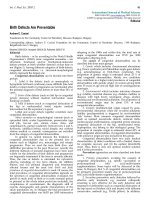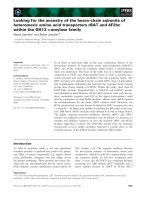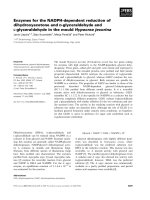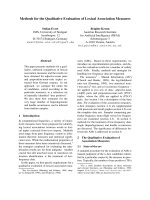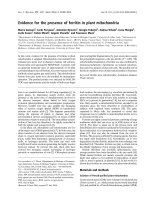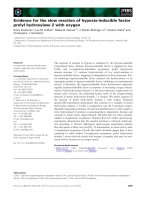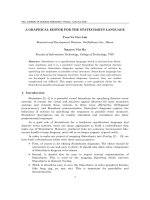Báo cáo " Balance of rice for the Mekong Delta - Viet Nam to 2050 in terms of industrialization and climate change '''' doc
Bạn đang xem bản rút gọn của tài liệu. Xem và tải ngay bản đầy đủ của tài liệu tại đây (200.17 KB, 7 trang )
International Journal of Agricultural Sciences ISSN: 2167-0447 Vol. 2 (1), pp. 040- 045, January, 2012.
Available online at www.internationalscholarsjournals.org © International Scholars Journals
Full Length Research Paper
Balance of rice for the Mekong Delta - Viet Nam to 2050
in terms of industrialization and climate change
Nguyen Van Song* and Do Thi Diep
Head of department of resources and environment economics, Hanoi University of Agriculture – Vietnam
Tel: (0084)438760222: Home:( 0084)438766448:Mobile:0984148879: fax: (0084)438276522
Received 11 December 2011; Accepted January 3, 2012
ABSTRACT
Rice area of the Mekong Delta (MD) has decreased in recent years, especially the shift from rice land
into land for industrial parks and saline land due to sea level rise and effects of climate change. In
addition, the rate of population growth also requires increasingly high demand for rice in the region. By
using the model, results showed that the population of the Mekong Delta will be at 26,956.5 thousand
inhabitants, paddy land is 993.9 thousand hectares, rice balance will achieve 4729.9 thousand tons in
2050. Scenarios of sea level rise due to the impact of climate change shows that the sea level rise to 0.3
m in 2050, corresponding to the rice area is reduced by 0.6 million hectares, the paddy land remained
only 851.6 thousand hectares, balance rice reached 2.6 million tons. Although rice yield and output
increased due to intensive investment and increasing the use of rice land, but the rate of declining rice
land under the influence of climate change and industrialization plus increasing population is faster led
to rice balance in 2050 only was 2.5 million tons. This is a huge pressure to national food security in the
near future. So the strategy set for the Mekong Delta in the near future is to stabilize rice area, slowing
population growth and application of scientific and technical measures to improve productivity and rice
output.
Keywords: rice land, population, rice output, industrialization, climate change.
1. BACKGROUND
Mekong Delta is one of the great, fertility deltas
of Southeast Asia and the world; is the production
area and export of food; is the biggest orchard of
Vietnam. Mekong Delta plays especially important
role in rice production in the country. Rice
production results in the region to decide the
national food security and maintain the rice export
position of Vietnam. Annually Mekong Delta was
flooded nearly 50% of the area from 3 to 4 months.
This creates the regional features. On the one hand,
it made big limits for cultivation, planting and
caused many difficulties for the lives of people,
otherwise also create favorable conditions for
fishing, aquaculture and add fertility to the
cultivated land.
With the advantage of large population (17.21
million in 2009), an abundant labor force, fertile
soil, stability climate has created favorable
conditions for rice production in the region.
However, agriculture in general and rice cultivation
in particular is spontaneous, fragmented, scattered,
and heavy influence of the industrialization
process, the rate of population growth and climate
change. According to the Ministry of Agriculture
and Rural Development, from 2000 to 2007, rice
area decreased an average area of 21,000 hectares
per year. The land is recovered mainly for the
construction of urban, industrial and other projects.
With the speed of the current land acquisition, in
2020 paddy land in the country is only 3.4 million
ha, while in the long term the risk of reducing rice
land in the Mekong Delta and some coastal areas is
very high when facing the sea level rise. Questions
about the supply of rice, rice output supply for the
region from now until 2050 with the role of
ensuring food security for all countries in the
context of population growth, climate change and
industrialization have been set for this study.
The basis objective of this study was to find
trends of main resources in agriculture, rice output
and food security for the Mekong delta by 2050.
*Corresponding Author’s Email:
2. RESEARCH METHODOLOGY
Secondary data sources used in the study was
obtained from the Department of Agriculture and
Rural Development, Department of Statistics,
Department of Planning and Investment,
Department of Science and Technology of the
provinces in the region. Primary data was collected
through household surveys 540 rice farmers in the
study area. Data sources used to run Cobb-Douglas
function, consider the factors affecting the yield as
well as the distribution of the rice area.
Factors affecting productivity are basic inputs,
indirectly affect to the total rice output and rice
supply variable in the dynamic equilibrium model.
Research using the dynamic modeling by Bruce
Hanon & Matthias to consider the change of socio-
economic phenomenon in the long time. The
relationship between three main variables in the
model (population-agricultural labor, cultivated
rice, internal rice demand and supply equilibrium )
is dynamic relationships over time. Population
fluctuations depend on the birth rate, mortality rate,
migration, immigration growth in population
leads to increase the labor in rice production
activity, increase rice output for consumption, and
increasing the paddy land for housing. Paddy land
is directly affected by climate change and
industrialization.
Outside the two factors directly endogenous
affect is the productivity and rice area, rice supply
of the Mekong delta also affected by other factors
such as fertilizer, labor, consumption in the region,
and exchange outside the region.
3. RESEARCH RESULTS
3.1 Status of rice production in Mekong delta
With the role of ensuring national food security
and export, rice production in the Mekong Delta
over the years gained considerable achievements.
The region's rice yield is higher than the national
average and continues to grow over the years
thanks to the high intensive cultivation. Period
2007 – 2009, average yield rose 2.15%, output
increased 4.72%.
Mekong Delta’s agricultural area is the largest in
the whole country.
Last time, thanks for reclaiming
land, making the most of unused land, plus
investment in the exploitation of irrigation,
application of technical measures aimed at
increasing the coefficient of land use, thus, paddy
land tends to increase in all three crops. However,
the effects of industrialization, the process of
economic restructuring in the sector has continued,
these will make the region's rice area decline
markedly.
Meanwhile, in the long-term, reduction
of arable land in the Mekong Delta and some
coastal plain is very high when facing the sea level
rise. According to the Ministry of Agriculture and
Rural Development, just 1 meter sea level rise, will
have up to 70-80% of the land was submerged.
Therefore, to maintain the role of ensuring food
security for the country, according to the Mekong
Delta Rice Institute, from 2010 to 2030, Mekong
delta has to stabilize annual rice area from 1780 to
1880 million hectares.
3.2 Analysis the changes of elements in the model
In the original script of the model using actual
values of the elements obtained from the secondary
resources from the provinces and the primary data
through farmers survey.
3.2.1 The trend of population and labor changes
Results showed that the population of the Mekong
Delta in 2050 to continue to increase. In 2010 the
region's population is 17.4 million people, in 2030 is
21.7 million and will be reaching 26.9 million in
2050. Research results also showed that agricultural
labor and labor involved in the production of rice
continue to increase in absolute terms, but the
structure tends to decrease. This is entirely consistent
with the trend of industrialization and modernization
process and economic restructuring is going strongly
today.
3.2.2 The trend of cultivated rice changes
The conversion of agricultural land into the
socioeconomic development objectives is taking
place on a national scale with the rapid speed. As
reported by the Ministry of Agriculture and Rural
Development, from 2000 to 2007, paddy land
Nguyen & Do 040 Int. J. Agric. Sci
decreased 361.935ha, fell nearly 51.705ha per year
on average. Where the Red River delta decreased
52.047ha and Mekong delta was 205.366ha
reduction. Parallel to the process of
industrialization and urbanization, the effects of
climate change has taken place strongly. This
greatly influenced the agricultural production in
general and rice production in particular. Currently,
when the effects are still low, the rate of loss of
farmland due to urbanization and climate change
was 1% (2).
According to the original script of the model,
with the rate of loss rice land by industrialization
and climate change as today, the Mekong Delta’s
paddy land is 1619.8 thousand ha in 2020 and is
only 993.9 thousand ha in 2050.
Fact and the above analysis shows that one of
the plans to rice land use issue is to protect current
agricultural land, taking measures to cope with
climate change right now, consider the problem of
industrialization and urbanization in a scientific,
strict control of agricultural land in association with
the overall planning of land use in other fields
toward developing harmoniously agriculture and
rural development.
Table 1: Rice production on Mekong delta period 2007 to 2009
Unit Unit
2007 2008 2009 Average
Output ratio (%) Output
ratio
(%)
Output
ratio
(%)
08/07 09/08 Ave.
1 Area
1000 ha
3683.1 100.00 3858.9 100.00 3872.9 100.00 104.77 100.36 102.54
- Spring Rice 1000 ha
1506.5 40.90 1526.5 39.56 1548.8 39.99 101.33 101.46 101.39
- Fall rice 1000 ha
1799.2 48.85 1939.8 50.27 1910.5 49.33 107.81 98.49 103.05
- Winter crop 1000 ha
377.4 10.25 392.6 10.17 413.6 10.68 104.03 105.35 104.69
2. Productivity
quintal/ha
50.7 53.6 52.9 105.72 98.69 102.15
- Spring Rice quintal/ha
60.2 64.4 63.6 106.98 98.76 102.79
- Fall rice quintal/ha
46.1 47.7 47.2 103.47 98.95 101.19
- Winter crop quintal/ha
34.9 40.3 38.9 115.47 96.53 105.58
3. Output
1000 tons
18678.9 100.00 20669.5 100.00 20483.4 100.00 110.66 99.10 104.72
- Spring Rice 1000 tons
9072.4 48.57 9833.2 47.57 9856.1 48.12 108.39 100.23 104.23
- Fall rice 1000 tons
8291.1 44.39 9253.1 44.77 9018.2 44.03 111.60 97.46 104.29
- Winter crop 1000 tons
1315.4 7.04 1583.2 7.66 1609.1 7.86 120.36 101.64 110.60
Source: Statistical Yearbook 2010
3.2.3 The trend of rice output changes
Rice output of Mekong Delta in 2050 tended to
decrease. Since rice output is influenced by the
yield, the total area and sown area structure,
therefore, although rice yield could increase by an
estimated 2.5% per year in 2020, but the rate of
decline of rice land more quickly, so rice output is
still declining. Specifically, as the results, rice
output of the Mekong Delta is approximately 18
million tons in 2020. By 2050 this number will
drop to more than 11 million tons.
3.2.4 Analysis the relationship between
population, cultivated land, and rice supply
The population of MD continues to grow while
rice land tends to decrease along with the process
of industrialization and climate change. Paddy land
decreased from 1823.8 thousand ha in 2010 down
to 993.9 thousand ha in 2050. From the rice
production and distribution aspects, with the goal of
achieving highest food security in term of rice
amount in 2010 is the most appropriate time for the
stabilization of rice land, not to decrease further.
But with the national goal is to become an
industrialized country by 2020 with the rapid speed
of industrialization, economic structure has shifting
trend, the Mekong Delta need to expand, build
Nguyen & Do 041 Int. J. Agric. Sci.
more of industrial park, transfer inefficient rice land
to aquaculture land. This change together with the
effects of climate change make the rice production
not balanced at the highest level that will reduce
quickly.
3.3 Analysis the change of population,
cultivated land, rice output when other factors
change
3.3.1 Variation in cultivated land and rice
supply when sea level rises
Climate change has caused disasters in Viet
Nam increasing in number, intensity and extent of
impact. According to "climate change scenario, sea
level rise for Vietnam" by Ministry of Natural
Resources and Environment made 06/2009, in the
case of sea level rise by 1 meter, the Mekong delta
will have 2 million ha saline farmland can not be
cultivated, which is mainly paddy land.
And according to this document, the results
calculated by the low emission scenario showed
that by 2050 sea levels would rise 0.3 m
corresponding to 0.6 million ha of Mekong Delta’s
rice land will be flooded. From 2000, rice land in
the Mekong Delta reduced 205.000ha; accounting
for 57% of the country's rice land is reduced at the
same time. The main reason is due to the recovery
land of provinces for the construction of urban
residential areas, industrial parks and many other
buildings.
Last time, due to reclamation and restoration of
land, so rice sown area is offset and expanded.
However, the reclamation and restoration land
almost disappeared, while climate change and sea
level rise could make Mekong delta lose from
15,000 to 20,000 km
2
land, of which there are many
rice sown area. From the above fact, the study
assumed that the paddy land expansion rate
decreased to 0.005%, rice land lost to rising sea
levels was 1.500ha/year.
Table 2: Comparing original scenario and scenario1
Items
Unit 2020 2030 2040 2050
OS
S1
(+,
-
)
OS
S1
(+,
-
)
OS
S1
(+,
-
)
OS
S1
(+,
-
)
-Population
1000 people
19414.6
19414.6
0
21659.2
21659.2
0
24163.0
24163.0
0
26956.5
26956.5
0
-Paddy land 1000 ha 1619.8
1580.6
-39.2 1412.2
1339.4
-72.8 1204.0
1096.4
-107.6 993.9
851.6
-142.3
-
Rice D-S -E 1000 tons 17425.3
16920.6
-504.7
13330.5
12292.0
-1038.5 9103.8
7531.5
-1572.3 4729.9
2623.7
-2106.2
-Distribution
+ Feed
1000 tons 1742.5 1692.1 -50.4 1333.0
1229.2
-103.8 910.4
753.2
-157.2 473.0
262.4
-210.6
+ food
1000 tons 5242.0 5242.0 0 5848.0
5848.0
0 6524.1
6524.1
0 7278.3
7278.3
0
+
Export
1000 tons 9008.9 8748.0 -260.9 6891.9
6355.0
-536.9 4706.7
3893.8
-812.9 2445.4
1356.5
-1088.9
Source: Results of the model
Original scenario: Expanded rate: 3.5%; land area lost due to sea level rise: 100 ha/year
Scenario 1: Expanded rate: 0.05%; land area lost due to sea level rise: 1500 ha/year
Results of scenario 1 showed that, the Mekong
delta’s paddy land in 2050 is 851.6 ha; it is lower
than the original plan is 142.3 ha. Rice output and
rice demand-supply equiplibrium (D-S-E) therefore
decrease 2.1 million tons, rice
D-S -E
only is 2.6
million tons in 2050. Assuming population growth
rate does not change, this decline has great
influence on the rice distribution for feed and
exports. If the rice for export is lower 260.9
thousand tons than original plan in 2020, by 2050
this number is more than 1 million tons. Therefore,
to maintain the role to ensure national food security
and exports, the Mekong Delta need the technology
measures to increase rice yields such as breeding
new rice varieties, to rinse the local rice varieties
adapted to climate change, pest resistance, high
yield, good quality rice, application of new measures
to create mutations, gene transfer compound
3.3.2 Changes in cultivate land and the demand
and supply equilibrium of rice since paddy land
transfer for industrialization reduced
Nguyen & Do 042 Int. J. Agric. Sci.
Recovery of agricultural land to use for the
socioeconomic development goals of the country
recently went on massively. This is a necessity,
however, according to Professor Logan (Logan
University - Australia): "The use of agricultural
land for urban development purposes and
protection of agricultural land is popular story, but
the most important in Vietnam today is this process
occurs fastest in the world". Notably, the majority
of agricultural land is recovered with good soil, for
2 rice crops per year. Meanwhile, rice land is
irreplaceable and significant decision for national
food security.
Article 74 of the Land Law 2003 stipulated:
"State policy to protect paddy land, restricting
transfer of paddy land to the use of non-agricultural
purposes. Where necessary to transfer a part of the
area for rice cultivation to be used for non-
agricultural purposes, the State shall take measures
to supplement or enhance the area of land for rice
cultivation”
Table 3: Comparing original scenario and scenario 2
Items Unit
2020 2030 2040 2050
OS
S1
(+,
-
)
OS
S1
(+,
-
)
OS
S1
(+,
-
)
OS
S1
(+,
-
)
-Population
1000
people
19414.6
19414.6
0
21659.2
21659.2
0
24163.0
24163.0
0
26956.5
26956.5
0
-Paddy land 1000 ha 1619.8
1684.8
65 1412.2
1538.2
126 1204.0
1390.0
186 993.9
1239.9
246
-
Rice D-S -E 1000 tons 17425.3
21533.1
4107.8
13330.5
18084.1
4753.6 9103.8
14500.1
5396.3 4729.9
10765.3
6035.4
-Distribution
+ Feed
1000 tons
1742.5 2153.3 410.8 1333.0
1808.4
475.4 910.4
1450.0
539.6 473.0
1076.5
603.5
+ food
1000 tons
5242.0 5242.0 0 5848.0
5848.0
0 6524.0
6524.0
0 7278.3
7278.3
0
+
Export
1000 tons
9008.9 11132.6
2123.7 6891.9
9349.5
2457.6 4706.7
7496.5
2789.8 2445.4
5565.7
3120.3
Source: Results of the model
Original scenario: Productivity growth rate: 0%; coefficient of land use: 2.1 times; cultivated land transfer for industrial land: 21000 ha
Scenario 1: Productivity growth rate: 2.5%; coefficient of land use: 2.3 times; cultivated land transfer for industrial land: 15000 ha
To ensure food security for both domestic and
export rice in the context of global climate change,
the Ministry of Agriculture and Rural
Development has planned from now to 2030,
Mekong delta has to stabilize an area of rice land is
8 million hectares, and this region has to stabilize
rice output per year from 19.5 to 21 million tons.
However, if rice land continues to reduce as
current rate, the Mekong Delta will reduce more
than 200,000 ha rice land, it means the reduction of
600.000ha of rice sown area, equivalent to more
than 3 million tons per year in 10 years.
Meanwhile, the Mekong Delta’s population and the
country's are growing, demand for food also
increased. Thus, according to experts, the Mekong
delta should not withdraw more paddy land to use
for other purposes; in addition, applying technical
measures to increase productivity and rice output.
Accordingly, in this scenario 2 we assume that rice
productivity will increase by 2.5%, coefficient of
land use increased 2.3 times per year, the paddy
land transfer for industrial purposes decreased
from 21.000ha per year down to 15.000 ha per
year.
Results when there are changes showed that,
paddy land and rice
D-S -E
tends to increase
compare to the original plan. By 2050, rice land
area increases to 246 ha and the rice
D-S -E
will
increase more than 3 million tons. With constant
population size, increase in rice D-S-E will lead to
distribution for other purposes such as livestock,
exports increased. The conditions for reclaimed
land area is no longer, the effects of climate change
to agriculture taken place complicatedly, then this
increase is extremely important for Vietnam: the
country is currently holding the second positions
rice in the world.
3.3.3 Changes in population, cultivated land, and
rice
D-S -E
when there are changes of all factors
The above analysis shows that rice land area of
the Mekong Delta is reduced by the impact of
industrialization and climate change. To ensure
Nguyen & Do 043 Int. J. Agric. Sci
food security and export demand, the region should
apply intensive measures to increase rice
productivity and rice output, reducing the rate of
population growth. In this scenario, the research
will consider the changes of rice
D-S -E
when there
are simultaneous effects of factors in relation to
changes in rice area due to industrialization and
climate change; rice productivity and rice output
increased; rate of population growth decreased.
Results of scenario 3, when there are above
changes shows that, paddy land was lower than the
original script for 361.6 thousand ha (in 2050).
Although rice land decreased by the process of
industrialization, urbanization and the impact of
climate change, however, increasing the coefficient
of rice land from 2.1 to 2.3 times, increasing
investments in rice production, rice output
therefore generally tends to increase compared to
1, 2 script.
The study also showed that growth speed of rice
output tends to decrease gradually due to reduced
levels of rice land for industrialization,
urbanization and climate change was faster than
the increase in rice yield due to application of
intensive measures to increase rice productivity.
With the rate of population growth decreased,
increasing in rice output made paddy land per
capital initially tends to increase on average; the
amount of food for grain therefore reduces to
nearly 1.2 million tons in 2050.
Especially, when socio-economics develop,
human life is raised, the average food per capita
decline in economics law of Engel (assuming
reduced from 270 kilos/person to 240
kilos/person), the distribution of grain for
livestock, export and other purposes will increase.
This is very significant in the process of
industrialization and economics restructuring of the
region.
Table 4: Comparing original scenario and scenario 3
Items
Unit
2020 2030 2040 2050
OS S1 (+,-) OS S1 (+,-) OS S1 (+,-) OS S1 (+,-)
-Population 1000 people 19414.6
19100.1
-314.5
21659.2
20994.2
-665
24163.0
23076.1
-1086.9
26956.5
25364.5
-1592
-Paddy land 1000 ha 1619.8
1538.6
-81.2 1412.2
1249.1
-163.1 1204.0
947.4
-256.6 993.9
632.3
-361.6
-
Rice D-S-E 1000 tons 17425.3
20356.5
2931.2
13330.5
14692.8
1362.3 9103.8
8752.9
-350.9 4729.9
2509.7
-2220.2
-Distribution
0 0 0 0
+ Feed
1000 tons
1742.5 2035.7 293.2 1333.0
1469.3
136.3 910.4
875.3
-35.1 473.0
251.0
-222.0
+ food
1000 tons
5242.0 4584.0 -658.0 5848.0
5038.6
-809.4 6524 5538.3
-985.7 7278.3
6087.5
-1190.8
+
Export
1000 tons
9008.9 10524.3
1515.4 6891.9
7596.2
704.3 4706.7
4525.3
-181.4 2445.4
1297.5
-1147.9
Source: Results of the model
Original scenario: Average paddy land/person: 270 kg; coefficient of land use: 2.1 times; Productivity growth rate: 0%;
population growth rate: 1.1%, land transfer for Industrialization: 21000 ha; land lost due to sea level rise: 100 ha/year;
expanded rate: 3.5%
Scenario 1: Average paddy land/person: 240 kg; coefficient of land use: 2.3 times; Productivity growth rate: 2.5%; population growth
rate: 0.95%; land transfer for Industrialization: 15000 ha; land lost due to sea level rise: 1500 ha/year; expanded rate: 0.05%
Thus, with the scenario of improving
productivity and rice output by the application of
intensive measures in terms of rice sown area tends
to decline, with the assumption of average rice
consumption/person decreases from 270kg/year to
240 kg/year according to economic laws, the
security of rice for the Mekong Delta in 2050 not
only is ensured but also will be redundant for
export.
However, this equilibrium can only be sustained
if the Mekong delta has timely measures to deal
with climate change, adapting to the effects of sea
level rise, controlling and planning of
industrialization, urbanization most closely.
4. CONCLUSIONS
Through the study of rice
D-S -E
for Mekong
Delta in terms of paddy land area decreased by
climate change and industrialization and
Nguyen & Do 044 Int. J. Agric. Sci
urbanization, the results allow the following
conclusions:
Firstly, the results of system analysis problem
considered in 2050, took time period is the rice
D-S
-E
was maintained with the current change of paddy
land. Until that time, the population of the Mekong
Delta will be at 26.96 million people, paddy land is
993.9 thousand hectares.
Secondly, the results in scenario 3 are the most
appropriate. Compared with other scenarios, rice
output in scenario 3 is not peaked, but in this
scenario, the rice D-S-E was 2.5 million tones. This
not only ensures food security but also the need for
livestock, export and other purposes. Besides, the
increase in intensive investment for rice production
was the cause of productivity and output growth,
ensuring national food security and export.
Thirdly, the Mekong Delta is one of the great
and fertile plains of Southeast Asian; is the food
production and export area of the most important in
the country. In the future, when the possibility of
reclaimed is no longer, climate change and sea
level rise make losing a considerable amount of
agricultural land, Mekong delta should reduce
paddy land move to industrialization and
urbanization to ensure national food security and
export.
Fourthly, the current consumption of the
Vietnamese average was 270 kilos of rice and 300
kilos of food grain/person/year. In scenario 3, with
the assumed average rice/person/year were 240 kg,
the results showed that consumer demand for rice
has declined the amount of grain for livestock and
export increased significantly. Due to practical
requirements on labor and employment, region
needs to have the strategies to promote livestock
development to take full advantage of surplus grain
production in the coming years.
Finally, population and labor have close
relationship. With the population growth rate of
1.1%, annual the Mekong Delta has to create jobs
for hundreds of thousands of workers. This is a
huge pressure for economic development of region,
where up to 85.67% of labor force untrained
(reported by the Ministry of Labor). So the strategy
of the population in the future is to stabilize
population size, improve the quality of human
resources. According to the calculation of the study
is to reduce the rate of population growth from
1.1% to 0.95%, the population size should be
maintained at 2564.5 thousand in 2050 to help
ensure food security in terms of rice land is
declining due to the effects of climate change and
industrialization and urbanization.
REFERENCES
Ministry of Agriculture and Rural Development,
2009. Framework program of action to adapt to
climate change in the Agriculture and Rural
Development in the period 2008-2010.
Ministry of Natural Resources and Environment,
2009. Scenarios of climate change and sea level
rise of Vietnam.
Bruce Hannon & Matthias Ruth, 1994. Dynamic
Modeling Springer - Verlag New York, lnc.
Vietnam Statistical Yearbook 2010.
Party Central Office and the Ministry of
Agriculture & Rural Development, 2009. Food
security strategy and national plan to paddy land
in 2020, Vision to 2030.
Nguyen & Do 045 Int. J. Agric. Sci
